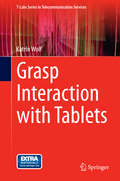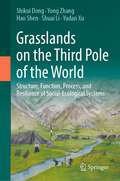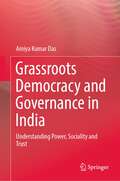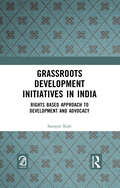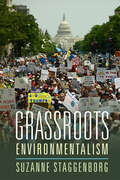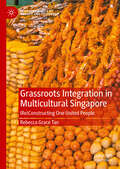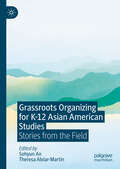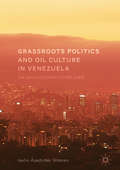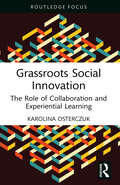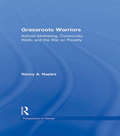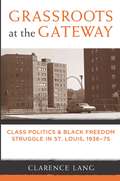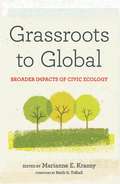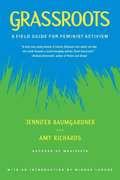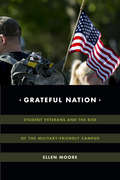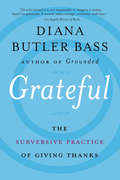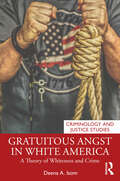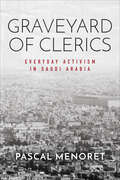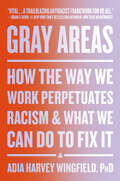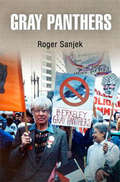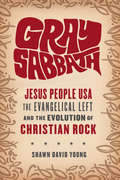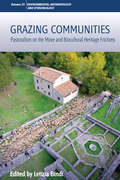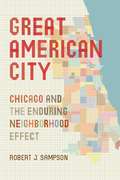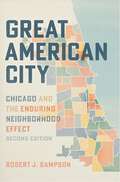- Table View
- List View
Grasp Interaction with Tablets
by Katrin WolfThis book presents guidelines for a future device type: a tablet that allows ergonomic front- and back-of-device interaction. These guidelines help designers and developers of user interfaces to build ergonomic applications for tablet devices, in particular for devices that enable back-of-device interaction. In addition, manufacturers of tablet devices obtain arguments that back-of-device interaction is a promising extension of the interaction design space and results in increased input capabilities, enriched design possibilities, and proven usability. The guidelines are derived from empirical studies and developed to fit the users' skills to the way the novel device type is held. Three particular research areas that are relevant to develop design guidelines for tablet interaction are investigated: ergonomic gestures, interaction areas, and pointing techniques.
Grasslands on the Third Pole of the World: Structure, Function, Process, and Resilience of Social-Ecological Systems
by Shikui Dong Yong Zhang Shuai Li Hao Shen Yudan XuThis book comprehensively covers the topics of origin and distribution, evolution and types, regional and global importance, biodiversity conservation, plant-soil interfaces, ecosystem functions and services, social-ecological systems, climate change adaptations, land degradation and restoration, grazing management and pastoral production, and sustainable future of the grasslands on the Qinghai-Tibetan Plateau (QTP), which is a globally unique eco-region called the "Roof of the World" because of its high elevation, “Third Pole on Earth" because of its alpine environment and the "Water Tower in Asia" because of its headwater location. The grassland ecosystem covers above 60% of QTP, which is about 2.5 million km2, 1/4 of Chinese total territorial lands. The grassland ecosystem of the QTP (the Third Pole) is an important part of the palaearctic region, which features alpine cover and low oxygen. The Third Pole's grasslands not only provide important ecosystem functions such as biodiversity conservation, carbon storage, water resource regulation, climate control, and natural disaster mitigation at a global scale, but also provide critical ecosystem services such as pastoral production, cultural inheritance, and tourism and recreation at local and regional scales. The purposes of this monograph are to address the following questions: (1) What are the special features of the Third Pole's grasslands? (2) How have climate changes and human activities changed the structures and functions of the Third Pole's grasslands? (3) How can we cope with land degradation and climate change through innovative restoration and protective actions for Third Pole's grasslands? And (4) How can we promote the sustainable development of social-ecological systems of the Third Pole's grasslands through best management practices including grazing? The goal of this book is to attract the attention of international audiences to realize the importance of the Third Pole’s grasslands, and to call for the actions of global communities to effectively protect and sustainably use the Third Pole's grasslands. This book can be served as textbooks, teaching materials and documentaries for different audiences. The target audiences include students, teachers, researchers, policy makers, planners, government officials, and NGOs in agricultural, environmental and natural resources sectors.
Grassroots Democracy and Governance in India: Understanding Power, Sociality and Trust
by Amiya Kumar DasThis book approaches grassroots governance and democracy from a sociological perspective, focusing on the interaction between the community and the State. It explores the interrelationship between state, governance and community and demonstrates the performativity aspects of both political actors and citizens in various elections in India. It also highlights the need to understand the dynamics of governance in a multi-ethnic society and democracy like India both at the micro and macro levels. Offering detailed explanations of formal and informal governance in people’s everyday lives, it reviews some of the key debates on governance with respect to the engagement of the community. This book is intended for academics, researchers, activists, planners and policymakers from a range of disciplines, such as sociology, public policy, social anthropology, development studies, politics and regional development, interested in governance and development in India.
Grassroots Development Initiatives in India: Rights Based Approach to Development and Advocacy
by Sampat KaleThis book examines how the voluntary organisations engaged with development programmes work with the approach of conscientisation to empower Adivasis. Their work has been instrumental in making government machinery pro-poor by implementing development programmes with greater transparency and accountability. Conscientisation of Adivasis by voluntary organisations through their educative role has resulted in the advancement of their lives and the emergence of autonomous leadership. The study concludes that the ideological base of the founders of the organisations made the Adivasis independent and self-supportive for their development from their earlier status of servitude through initiating and accomplishing the task of conscientisation. This title is co-published with Aakar Books. Print editions not for sale in South Asia (India, Sri Lanka, Nepal, Bangladesh, Pakistan and Bhutan)
Grassroots Environmentalism (Cambridge Studies in Contentious Politics)
by Suzanne StaggenborgGrassroots activism is essential to the success of the contemporary environmental movement, which depends on the organization of local activists as well as state, national, and international organizations. Yet grassroots activists confront numerous challenges as they attempt to organize diverse participants and devise fresh strategies and tactics. Drawing on more than seven years of fieldwork following diverse organizations in Pittsburgh over time, this book sheds light on the struggles that activists face and the factors that sustain movements. Suzanne Staggenborg examines individual motivations and participation, organizational structures and cultures, relationships in movement communities, and strategies and tactics, including issue framing. The book shows that collective action campaigns and tactics generate solidarity, maintain involvement, and bring in new participants even as organizers struggle to devise effective new types of actions.
Grassroots Integration in Multicultural Singapore: (Re)Constructing One United People (Palgrave Politics of Identity and Citizenship Series)
by Rebecca Grace TanThis book studies the role that grassroots volunteers play in the integration and naturalization process in Singapore. With increasing migration, the topics of migrant integration and belonging are of perennial academic and public interest. However, much of the existing literature on the subject is largely focused on European and North American cases. By focusing on the single case of Singapore, this project provides a story of how a city-state grapples with the issue of managing increasing cultural diversity while seeking to maintain a cohesive identity. As a city, Singapore has many ubiquitous features of other urban centres for migration, such as a rapidly diversifying population and an economy that is heavily reliant on foreign labour. At the same time, being a city-state means that the demographic and cultural changes experienced in Singapore also coincide with questions of national belonging and membership in the nation-state, in contrast to larger countries with rural-urban divides or more decentralized systems of migration management and integration. Examining this simultaneously typical yet unique case study means that this project is able to examine the processes where state and society have managed migration and cultural diversity at the level of the nation-state. For example, this project discusses how Singapore’s policy of multiracialism complements nation-building efforts, adding to existing public and academic debate about whether societies can concurrently embrace cultural difference yet maintain a cohesive national identity.
Grassroots Organizing for K-12 Asian American Studies: Stories from the Field
by Sohyun An Theresa Alviar-MartinThis edited book captures Asian American grassroot organizing in Georgia through counterstorytelling. Rooted in Critical Race Theory and traditions of narrative inquiry, counterstorytelling in educational research seeks to challenge dominant narratives by centering marginalized communities’ experiences and perspectives as sources of valuable knowledge. By employing AsianCrit, global citizenship education, human rights, and liberatory postcolonial education as theoretical lenses, the editors of this book interrupt essentialized portrayals of Asian Americans by featuring stories of Asian American students, parents, and educators who are fighting for Asian American Studies and Ethnic Studies in K-12 schools in Georgia. Their stories capture common as well as divergent experiences of being Asian American in the South and illuminate possibilities, challenges, and complexity of grassroots organizing for Asian American studies and ethnic studies in the South.
Grassroots Politics and Oil Culture in Venezuela: The Revolutionary Petro-State
by Iselin Åsedotter StrønenThis book is published open access under a CC BY 4.0 license.This book presents an ethnographic study of how grassroots activism in Venezuela during the Chávez presidency can be understood in relation to the country's history as a petro-state. Taking the contested relationship between the popular sectors and the Venezuelan state as a point of departure, Iselin Åsedotter Strønen explores how notions such as class, race, state, bureaucracy, popular politics, capitalism, neoliberalism, consumption, oil wealth, and corruption gained salience in the Bolivarian process. A central argument is that the Bolivarian process was an attempt to challenge the practices, ideas, and values inherited from Venezuela's historical development as an oil-producing state. Drawing on rich ethnographic material from Caracas' shantytowns, state institutions, as well as everyday life and public culture, Strønen explores the complexities and challenges in fostering deep social and political change.
Grassroots Social Innovation: The Role of Collaboration and Experiential Learning (Routledge Focus on Business and Management)
by Karolina OsterczukThis book examines the transformative power of grassroots social innovations within dynamic urban landscapes. From addressing access to healthy food to navigating regulatory challenges, urban citizens are taking charge of their environments through collective action. This ethnographic exploration explores the everyday workings of three grassroots initiatives, highlighting the practices driving social change.Readers will discover practical models for collective organizing within social innovation communities, offering insights for both activists and policymakers eager to effect change in urban life. By emphasizing collaboration as a cornerstone of social innovation, this book illuminates how deep engagement fosters reflectivity, empathy, and sustainability within communities. Drawing on multidimensional collaboration models, readers gain practical tools for creating lasting social impact.Moreover, the book places these insights within a broader European context and references Elinor Ostrom's theory of the common good, appealing to readers worldwide interested in community-driven solutions. With qualitative research conducted in Poland, this book offers a rich tapestry of insights into the global phenomenon of grassroots social innovation, encouraging reflection and action among urban communities worldwide.
Grassroots Warriors: Activist Mothering, Community Work, and the War on Poverty (Perspectives on Gender)
by Nancy A. NaplesFirst published in 1998. Routledge is an imprint of Taylor & Francis, an informa company.
Grassroots at the Gateway
by Clarence Lang"This is a theoretically sophisticated and thoroughly documented historical case study of the movements for African American liberation in St. Louis. Through detailed analysis of black working class mobilization from the depression years to the advent of Black Power, award-winning historian Clarence Lang describes how the advances made in earlier decades were undermined by a black middle class agenda that focused on the narrow aims of black capitalists and politicians. The book is a major contribution to our understanding of the black working class insurgency that underpinned the civil rights and Black Power campaigns of the twentieth century. " ---V. P. Franklin, University of California, Riverside "A major work of scholarship that will transform historical understanding of the pivotal role that class politics played in both civil rights and Black Power activism in the United States. Clarence Lang's insightful, engagingly written, and well-researched study will prove indispensable to scholars and students of postwar American history. " ---Peniel Joseph, Brandeis University Breaking new ground in the field of Black Freedom Studies,Grassroots at the Gatewayreveals how urban black working-class communities, cultures, and institutions propelled the major African American social movements in the period between the Great Depression and the end of the Great Society. Using the city of St. Louis in the border state of Missouri as a case study, author Clarence Lang undermines the notion that a unified "black community" engaged in the push for equality, justice, and respect. Instead, black social movements of the working class were distinct from---and at times in conflict with---those of the middle class. This richly researched book delves into African American oral histories, records of activist individuals and organizations, archives of the black advocacy press, and even the records of the St. Louis' economic power brokers whom local black freedom fighters challenged. Grassroots at the Gatewaycharts the development of this race-class divide, offering an uncommon reading of not only the civil rights movement but also the emergence and consolidation of a black working class. Clarence Lang is Assistant Professor in African American Studies and History at the University of Illinois at Urbana-Champaign. Photo courtesy Western Historical Manuscript Collection, University of Missouri, St. Louis
Grassroots to Global: Broader Impacts of Civic Ecology
by David MaddoxAddressing participatory, transdisciplinary approaches to local stewardship of the environment, Grassroots to Global features scholars and stewards exploring the broad impacts of civic engagement with the environment.Chapters focus on questions that include: How might faith-based institutions in Chicago expand the work of church-community gardens? How do volunteer "nature cleaners" in Tehran attempt to change Iranian social norms? How does an international community in Baltimore engage local people in nature restoration while fostering social equity? How does a child in an impoverished coal mining region become a local and national leader in abandoned mine restoration? And can a loose coalition that transforms blighted areas in Indian cities into pocket parks become a social movement? From the findings of the authors’ diverse case studies, editor Marianne Krasny provides a way to help readers understand the greater implications of civic ecology practices through the lens of multiple disciplines.Contributors:Aniruddha Abhyankar, Martha Chaves, Louise Chawla, Dennis Chestnut, Nancy Chikaraishi, Zahra Golshani, Lance Gunderson, Keith E. Hedges, Robert E. Hughes, Rebecca Jordan, Karim-Aly Kassam, Laurel Kearns, Marianne E. Krasny, Veronica Kyle, David Maddox, Mila Kellen Marshall, Elizabeth Whiting Pierce, Rosalba Lopez Ramirez, Michael Sarbanes, Philip Silva, Traci Sooter, Erika S. Svendsen, Keith G. Tidball, Arjen E. J. Wals, Rebecca Salminen Witt, Jill Wrigley
Grassroots: A Field Guide for Feminist Activism
by Jennifer Baumgardner Amy RichardsFrom the authors of Manifesta, an activism handbook that illustrates how to truly make the personal political. Grassroots is an activism handbook for social justice. Aimed at everyone from students to professionals, stay-at-home moms to artists, Grassroots answers the perennial question: What can I do? Whether you are concerned about the environment, human rights violations in Tibet, campus sexual assault policies, sweatshop labor, gay marriage, or the ongoing repercussions from 9-11, Jennifer Baumgardner and Amy Richards believe that we all have something to offer in the fight against injustice. Based on the authors' own experiences, and the stories of both the large number of activists they work with as well as the countless everyday people they have encountered over the years, Grassroots encourages people to move beyond the "generic three" (check writing, calling congresspeople, and volunteering) and make a difference with clear guidelines and models for activism. The authors draw heavily on individual stories as examples, inspiring readers to recognize the tools right in front of them--be it the office copier or the family living room--in order to make change. Activism is accessible to all, and Grassroots shows how anyone, no matter how much or little time they have to offer, can create a world that more clearly reflects their values.
Grateful Nation: Student Veterans and the Rise of the Military-Friendly Campus
by Ellen MooreIn today's volunteer military many recruits enlist for the educational benefits, yet a significant number of veterans struggle in the classroom, and many drop out. The difficulties faced by student veterans have been attributed to various factors: poor academic preparation, PTSD and other postwar ailments, and allegedly antimilitary sentiments on college campuses. In Grateful Nation Ellen Moore challenges these narratives by tracing the experiences of Iraq and Afghanistan war veterans at two California college campuses. Drawing on interviews with dozens of veterans, classroom observations, and assessments of the work of veteran support organizations, Moore finds that veterans' academic struggles result from their military training and combat experience, which complicate their ability to function in civilian schools. While there is little evidence of antimilitary bias on college campuses, Moore demonstrates the ways in which college programs that conflate support for veterans with support for the institutional military lead to suppression of campus debate about the wars, discourage antiwar activism, and encourage a growing militarization.
Grateful: The Transformative Power of Giving Thanks
by Diana Butler BassThe author of the multiple award-winning Grounded and leading trend spotter in contemporary Christianity explores why gratitude is missing as a modern spiritual practice, offers practical suggestions for reclaiming it, and illuminates how the shared practice of gratitude can lead to greater connection with God, our world, and our own souls.More and more people are finding God beyond the walls of traditional religious institutions, but these seekers often miss the church community itself, including its shared spiritual practices such as gratitude. While four out of five Americans have told pollsters they feel gratitude in their daily lives, cultural commentator and religion expert Diana Butler Bass finds that claim to be at odds with the discontent that permeates modern society.There is a gap, she argues, between our desire to be grateful and our ability to behave gratefully—a divide that influences our understanding of morality, worship, and institutional religion itself. In Grateful, Bass challenges readers to think about the impact gratitude has in our spiritual lives, and encourages them to make gratitude a "difficult and much-needed spiritual practice for our personal lives and to make a better world."Grateful is partially an individual, emotional response to our circumstances, but research has shown that what we often miss is how much more it is a communal, actionable response. Bass examines this more unexpected experience of gratitude, and reveals how people and communities can practice it and thrive, whether or not they are part of a traditional religious community.
Gratuitous Angst in White America: A Theory of Whiteness and Crime (Criminology and Justice Studies)
by Deena A. IsomGratuitous Angst in White America presents a new criminological theory that explains the racialized experiences of white people. Unlike orthodox traditions that assume whiteness as normative or progressive traditions that center the experiences of the marginalized and oppressed, the theory of whiteness and crime flips those perspectives and turns a lens toward white people’s lived experiences and the ideologies of whiteness. The theory of whiteness and crime answers two overarching questions: How does being white impact one’s likelihood of engaging in deviant, criminal, and/or violent behaviors? And, why are white people treated differently than other racial and ethnic groups by the criminal legal system? Through the application of a critical whiteness perspective to criminology, the theory of whiteness and crime is an intersectional and integrated framework that explains within (and between) group differences in negative behaviors and entanglements with the criminal legal system.This book examines the racialized history of America to contextualize the current racial strife in society and inform a more nuanced theoretical approach to explaining disparities. The reader will gain a socio-historical understanding of the depths of the current divides and insight into how such are perpetuated and potentially dismantled. Students will see connections between various theoretical traditions and an application of theory to current social conditions. Researchers will acquire a new theoretical foundation and propositions to ground empirical work that will fill extensive gaps in the criminological literature. And policy makers will see how oversights in understanding the depths of historical significance perpetuate and increase disparities and disadvantages, which are counter to a pursuit of justice.Written in a compelling and direct way, this book will appeal to those in criminology, sociology, race and ethnic studies, gender and sexuality studies, political science, cultural studies, psychology, criminal justice, law, and beyond. Gratuitous Angst in White America is essential for those seeking a more complete understanding of the associations between race and crime and those who want to remedy those disparities. In the end, it is more than a new theory of crime, it is a call to action for all willing to hear.
Graveyard of Clerics: Everyday Activism in Saudi Arabia (Stanford Studies in Middle Eastern and Islamic Societies and Cultures)
by Pascal MenoretThe inside story of political protest in Saudi Arabia—on the ground, in the suburbs, and in the face of increasing state repression. Graveyard of Clerics takes up two global phenomena intimately linked in Saudi Arabia: urban sprawl and religious activism. Saudi suburbia emerged after World War II as citizens fled crowded inner cities. Developed to encourage a society of docile, isolated citizens, suburbs instead opened new spaces for political action. Religious activists in particular turned homes, schools, mosques, and summer camps into resources for mobilization. With the support of suburban grassroots networks, activists won local elections and found opportunities to protest government actions—until they faced a new wave of repression under the current Saudi leadership. Pascal Menoret spent four years in Saudi Arabia in the places where today's Islamic activism first emerged. With this book, he tells the stories of the people actively countering the Saudi state and highlights how people can organize and protest even amid increasingly intense police repression. This book changes the way we look at religious activism in Saudi Arabia. It also offers a cautionary tale: the ongoing repression by Saudi elites—achieved often with the complicity of the international community—is shutting down grassroots political movements with significant consequences for the country and the world.
Gray Areas: How the Way We Work Perpetuates Racism and What We Can Do to Fix It
by Adia Harvey WingfieldGray Areas has descriptive copy which is not yet available from the Publisher.
Gray Divorce: What We Lose and Gain from Mid-Life Splits
by Jocelyn CrowleyAfter twenty, thirty, or even forty years of marriage, countless vacations together, raising well-adjusted children, and sharing property and finances—what could go wrong? Gray Divorce offers a provocative look at the growing rate of marital splits after the age of 50, showcasing the voices of men and women who are considering, going through, or have undergone one. With empathy and insight, Jocelyn Crowley, who has written widely on family issues, uncovers the reasons for why men and women divorce—and the penalties and benefits that each pay for their choice. From the outside, many may ask why couples in mid-life and readying for retirement choose to make a drastic change in their marital status. Yet nearly 1 out of every 4 divorces is “gray.” Crowley sheds light on why divorce occurs—seeing marriage in a different lens, understanding the seismic shift in individual priorities, and the impact of the increase in life expectancy. With a deft eye, she analyzes the experiences of women and men as they go through this life transition—specifically how women are affected economically while men are affected socially. With a realistic yet passionate voice, Crowley shares the personal positive outlooks and the necessary supportive public policies that must take place to best help new divorcees. Engaging and instructive, Gray Divorce is a must-read for anyone interested in contemporary American culture.
Gray Panthers
by Roger SanjekIn 1970, a sixty-five-year-old Philadelphian named Maggie Kuhn began vocally opposing the notion of mandatory retirement. Taking inspiration from the civil rights and anti-Vietnam War movements, Kuhn and her cohorts created an activist organization that quickly gained momentum as the Gray Panthers. After receiving national publicity for her efforts--she even appeared on the Tonight Show with Johnny Carson--she gained thousands of supporters, young and old. Their cause expanded to include universal health care, nursing home reform, affordable and accessible housing, defense of Social Security, and elimination of nuclear weapons.Gray Panthers traces the roots of Maggie Kuhn's social justice agenda to her years as a YWCA and Presbyterian Church staff member. It tells the nearly forty-year story of the intergenerational grassroots movement that Kuhn founded and its scores of local groups. During the 1980s, more than one hundred chapters were tackling local and national issues. By the 1990s the ranks of older members were thinning and most young members had departed, many to pursue careers in public service. But despite its challenges, including Kuhn's death in 1995, the movement continues today.Roger Sanjek examines Gray Panther activism over four decades. Here the inner workings and dynamics of the movement emerge: the development of network leadership, local projects and tactics, conflict with the national office, and the intergenerational political ties that made the group unique among contemporary activist groups. Part ethnography, part history, part memoir, Gray Panthers draws on archives and interviews as well as the author's thirty years of personal involvement. With the impending retirement of the baby boomers, Sanjek's book will surely inform the debates and discussions to follow: on retirement, health care, and many other aspects of aging in a society that has long valued youth above all.
Gray Sabbath: Jesus People USA, the Evangelical Left, and the Evolution of Christian Rock
by Shawn YoungFormed in 1972, Jesus People USA is an evangelical Christian community that fundamentally transformed the American Christian music industry and the practice of American evangelicalism, which continues to evolve under its influence. In this fascinating ethnographic study, Shawn David Young replays not only the growth and influence of the group over the past three decades but also the left-leaning politics it developed that continue to serve as a catalyst for change.Jesus People USA established a still-thriving Christian commune in downtown Chicago and a ground-breaking music festival that redefined the American Christian rock industry. Rather than join "establishment" evangelicalism and participate in what would become the megachurch movement, this community adopted a modified socialism and embraced forms of activism commonly associated with the New Left. Today the ideological tolerance of Jesus People USA aligns them closer to liberalism than to the religious right, and Young studies the embodiment of this liminality and its challenge to mainstream evangelical belief. He suggests the survival of this group is linked to a growing disenchantment with the separation of public and private, individual and community, and finds echoes of this postmodern faith deep within the evangelical subculture.
Grazing Communities: Pastoralism on the Move and Biocultural Heritage Frictions (Environmental Anthropology and Ethnobiology #29)
by Letizia BindiPastoralism is a diffused and ancient form of human subsistence and probably one of the most studied by anthropologists at the crossroads between continuities and transformations. The present critical discourse on sustainable and responsible development implies a change of practices, a huge socio-economic transformation, and the return of new shepherds and herders in different European regions. Transhumance and extensive breeding are revitalized as a potential resource for inner and rural areas of Europe against depopulation and as an efficient form of farming deeply influencing landscape and functioning as a perfect eco-system service. This book is an occasion to reconsider grazing communities’ frictions in the new global heritage scenario.
Great American City
by Robert J. SampsonFor over fifty years numerous public intellectuals and social theorists have insisted that community is dead. Some would have us believe that we act solely as individuals choosing our own fates regardless of our surroundings, while other theories place us at the mercy of global forces beyond our control. These two perspectives dominate contemporary views of society, but by rejecting the importance of place they are both deeply flawed. Based on one of the most ambitious studies in the history of social science, Great American City argues that communities still matter because life is decisively shaped by where you live. To demonstrate the powerfully enduring impact of place, Robert J. Sampson presents here the fruits of over a decade’s research in Chicago combined with his own unique personal observations about life in the city, from Cabrini Green to Trump Tower and Millennium Park to the Robert Taylor Homes. He discovers that neighborhoods influence a remarkably wide variety of social phenomena, including crime, health, civic engagement, home foreclosures, teen births, altruism, leadership networks, and immigration. Even national crises cannot halt the impact of place, Sampson finds, as he analyzes the consequences of the Great Recession and its aftermath, bringing his magisterial study up to the fall of 2010. Following in the influential tradition of the Chicago School of urban studies but updated for the twenty-first century, Great American City is at once a landmark research project, a commanding argument for a new theory of social life, and the story of an iconic city.
Great American City: Chicago and the Enduring Neighborhood Effect
by Robert J. SampsonFor over fifty years numerous public intellectuals and social theorists have insisted that community is dead. Some would have us believe that we act solely as individuals choosing our own fates regardless of our surroundings, while other theories place us at the mercy of global forces beyond our control. These two perspectives dominate contemporary views of society, but by rejecting the importance of place they are both deeply flawed. Based on one of the most ambitious studies in the history of social science, Great American City argues that communities still matter because life is decisively shaped by where you live. To demonstrate the powerfully enduring impact of place, Robert J. Sampson presents here the fruits of over a decade’s research in Chicago combined with his own unique personal observations about life in the city, from Cabrini Green to Trump Tower and Millennium Park to the Robert Taylor Homes. He discovers that neighborhoods influence a remarkably wide variety of social phenomena, including crime, health, civic engagement, home foreclosures, teen births, altruism, leadership networks, and immigration. Even national crises cannot halt the impact of place, Sampson finds, as he analyzes the consequences of the Great Recession and its aftermath, bringing his magisterial study up to the fall of 2010. Following in the influential tradition of the Chicago School of urban studies but updated for the twenty-first century, Great American City is at once a landmark research project, a commanding argument for a new theory of social life, and the story of an iconic city.
Great American City: Chicago and the Enduring Neighborhood Effect
by Robert J. SampsonGreat American City demonstrates the powerfully enduring impact of place. Based on one of the most ambitious studies in the history of social science, Robert J. Sampson’s Great American City presents the fruits of over a decade’s research to support an argument that we all feel and experience every day: life is decisively shaped by your neighborhood. Engaging with the streets and neighborhoods of Chicago, Sampson, in this new edition, reflects on local and national changes that have transpired since his book’s initial publication, including a surge in gun violence and novel forms of segregation despite an increase in diversity. New research, much of it a continuation of the influential discoveries in Great American City, has followed, and here, Sampson reflects on its meaning and future directions. Sampson invites readers to see the status of the research initiative that serves as the foundation of the first edition—the Project on Human Development in Chicago Neighborhoods (PHDCN)—and outlines the various ways other scholars have continued his work. Both accessible and incisively thorough, Great American City is a must-read for anyone interested in cutting-edge urban sociology and the study of crime.
